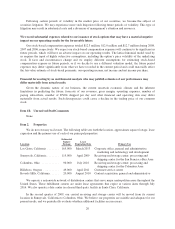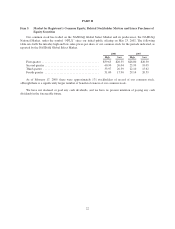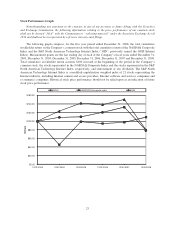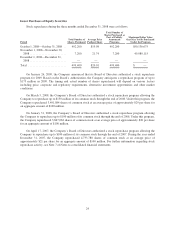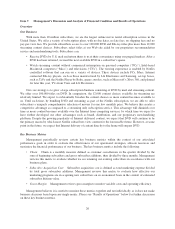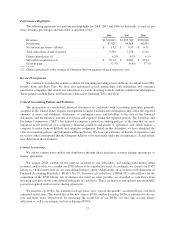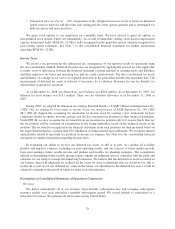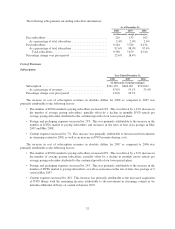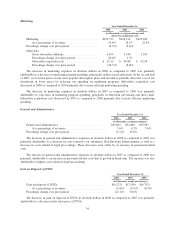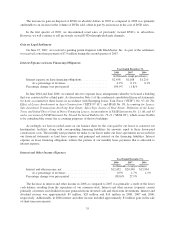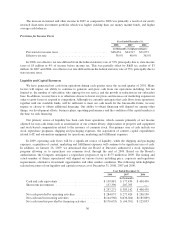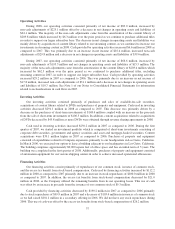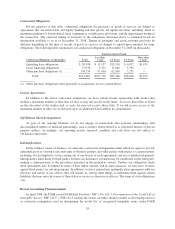NetFlix 2008 Annual Report Download - page 34
Download and view the complete annual report
Please find page 34 of the 2008 NetFlix annual report below. You can navigate through the pages in the report by either clicking on the pages listed below, or by using the keyword search tool below to find specific information within the annual report.•Suboptimal Exercise Factor: Our computation of the suboptimal exercise factor is based on historical
option exercise behavior and the terms and vesting periods of the options granted, and is determined for
both executives and non-executives.
We grant stock options to our employees on a monthly basis. We have elected to grant all options as
non-qualified stock options which vest immediately. As a result of immediate vesting, stock-based compensation
expense determined under SFAS No. 123(R) is fully recognized on the grant date and no estimate is required for
post-vesting option forfeitures. See Note 7 to the consolidated financial statements for further information
regarding SFAS No. 123(R).
Income Taxes
We record a tax provision for the anticipated tax consequences of our reported results of operations using
the asset and liability method. Deferred income taxes are recognized by applying the enacted tax rates applicable
to future years to differences between the financial statement carrying amounts of existing assets and liabilities
and their respective tax bases and operating loss and tax credit carryforwards. The effect on deferred tax assets
and liabilities of a change in tax rates is recognized in income in the period that includes the enactment date. The
measurement of deferred tax assets is reduced, if necessary, by a valuation allowance for any tax benefits for
which future realization is uncertain.
As of December 31, 2008, our deferred tax asset balance was $28.0 million. As of December 31, 2007, our
deferred tax asset balance was $19.1 million. There was no valuation allowance as of December 31, 2008 or
2007.
During 2007, we adopted the Financial Accounting Standard Board’s (“FASB”) Financial Interpretation No.
(“FIN”) 48, Accounting for Uncertainty in Income Taxes—an interpretation of FASB Statement No. 109 (“FIN
48”). FIN 48 changes the accounting for uncertainty in income taxes by creating a new framework for how
companies should recognize, measure, present and disclose uncertain tax positions in their financial statements.
Under FIN 48, we may recognize the tax benefit from an uncertain tax position only if it is more likely than not
the tax position will be sustained on examination by the taxing authorities, based on the technical merits of the
position. The tax benefits recognized in the financial statements from such positions are then measured based on
the largest benefit that has a greater than 50% likelihood of being realized upon settlement. We recognize interest
and penalties related to uncertain tax positions in income tax expense. See Note 8 to the consolidated financial
statements for further information regarding income taxes.
In evaluating our ability to recover our deferred tax assets, in full or in part, we consider all available
positive and negative evidence, including our past operating results, and our forecast of future market growth,
forecasted earnings, future taxable income and prudent and feasible tax planning strategies. The assumptions
utilized in determining future taxable income require significant judgment and are consistent with the plans and
estimates we are using to manage the underlying businesses. We believe that the deferred tax assets recorded on
our balance sheet will ultimately be realized. In the event we were to determine that we would not be able to
realize all or part of our net deferred tax assets in the future, an adjustment to the deferred tax assets would be
charged to earnings in the period in which we make such determination.
Descriptions of Consolidated Statements of Operations Components
Revenues
We derive substantially all of our revenues from monthly subscription fees and recognize subscription
revenues ratably over each subscriber’s monthly subscription period. We record refunds to subscribers as a
reduction of revenues. We generate all our revenues in the United States.
29



